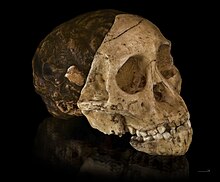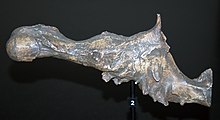20:
215:
136:
58:
119:, are closed, and the liquid rubber is slushed around in the empty cranial vault and then left to set. The resulting hollow sphere can then be drained of air like a balloon and pulled out through the
45:
in the study of brain development in humans and other organisms. Endocasts can be artificially made for examining the properties of a hollow, inaccessible space, or they may occur naturally through
123:. Rubber endocasts like these were the standard practice until the end of the 20th century and are still used in some fields. However, scientists are increasingly utilizing
202:
brain vault, showing the animal had limited intelligence and a well-developed sense of smell. The oldest known natural cranial endocast is a fossil fish brain from a
94:. While an endocast can not directly reveal brain structure, it can allow scientists to gauge the size of areas of the brain situated close to the surface, notably
584:
Glørstad, Håkon; Nakrem, Hans Arne; Ørhaug, Vanja (November 2004). "Nature in society: reflections over a
Mesolithic sculpture of a fossilised shell".
178:
in place. Such "fossil brains" are known from several hundred different mammal species. More than a hundred natural casts of the cranial vault of
230:
Endocast fossils from animals with shells that easily disintegrate or dissolve can often be encountered free from their mold fossil, like the
558:
272:, while some bivalve endocasts are traditionally known as heart-of-stone or bull hearts in Britain. The "Venus of Svinesund", an early
294:
Artificial endocasts are sometimes made from blood vessels for medical or anatomical reasons. The blood vessel of an organ (e.g.
500:
Wilson, J.A. (1971). "Early
Tertiary vertebrate faunas, Vieja Group: Trans- Pecos Texas: Agriochoeridae and Merycoidodontidae".
345:
163:
found, consists of a natural endocast connected to the facial portion of the skull. It was the shape of the brain that allowed
529:
463:
287:
bivalve endocast. Endocasts are also known to develop from snail shells and sea urchins, and even from the stomach hollow of
429:(Compl. rev. and updated version of "The successful dragons" ed.). Cambridge, Massachusetts: Harvard University Press.
434:
306:. When it is set, the organ itself is dissolved, leaving a three-dimensional image of the blood supply to the organ.
630:
349:
127:
scanning technology to create digital endocasts in order to avoid risking damage to valuable specimens.
29:
544:
341:
19:
640:
337:
124:
645:
635:
479:
451:
8:
601:
398:
371:
185:
95:
372:"The Emergence of Language in the Hominin Lineage: Perspectives from Fossil Endocasts"
605:
525:
459:
430:
423:
403:
87:
329:
174:
Mammal endocasts are particularly useful, as they resemble the fresh brain with the
625:
593:
393:
383:
159:
63:
516:
276:
269:
99:
167:
to conclude that the fossil was that of a human relative rather than an extinct
458:(2nd ed.). Bloomington, Ind.: Indiana University Press. pp. 191–208.
146:
115:
597:
484:
A Century of Nature: Twenty-One
Discoveries that Changed Science and the World
619:
388:
198:
141:
42:
487:
407:
214:
164:
83:
135:
113:
or rubber-like material. The openings to the brain cavity, except for the
203:
154:
57:
24:
284:
273:
252:
243:
239:
223:
219:
188:) alone are known, some having identifiable features down to the major
180:
175:
68:
330:"Paleoneurology: The study of brain endocasts of extinct vertebrates"
288:
231:
90:
to study brain structures and hemispheric specialization in extinct
247:
193:
91:
71:
235:
515:
Jerison, H.J. (2009). "Dinosaur Brains". In Squire, L.R. (ed.).
41:
is the internal cast of a hollow object, often referring to the
280:
110:
103:
46:
303:
299:
295:
257:
189:
168:
454:. In Brett-Surman, M. K.; Holtz, Thomas R. Jr (eds.).
242:. A frequently occurring form is the internal mold of
153:
Natural cranial endocasts are also known. The famous
583:
109:
Traditionally, the casting material is some form of
422:
617:
33:, with the facial portion of the skull attached
209:
102:, responsible for interpreting and producing
556:
545:Oldest Fossil Brain Find Is 'Really Bizarre'
291:, a group that rarely leaves fossil traces.
250:. In the quite symmetrical genus brachiopod
363:
449:
397:
387:
323:
321:
319:
213:
134:
56:
18:
514:
420:
369:
23:A natural endocast of the brain of the
618:
499:
346:National Museum of Health and Medicine
334:Comparative Mammalian Brain Collection
316:
226:, showing the internal shell structure
559:"Schamstein-Therapie nach Krötenbiss"
425:Dinosaurs, spitfires, and sea dragons
268:("shame stone" or "mother stone") in
480:Raymond Dart and our African Origins
130:
52:
327:
192:. Several hundred casts of various
77:
13:
557:von Werfring, Johan (2015-05-21).
14:
657:
450:Buchholtz, Emily (27 June 2012).
145:cranial vault, showing extensive
260:, giving these fossils the name
16:Internal cast of a hollow object
586:Norwegian Archaeological Review
577:
376:Frontiers in Human Neuroscience
139:Natural (fossil) endocast of a
82:Endocasts of the inside of the
550:
538:
508:
502:Texas Memorial Museum Bulletin
493:
472:
443:
414:
206:, some 300 million years old.
86:(braincase) are often made in
1:
563:Museumsstücke, ProgrammPunkte
421:McGowan, Christopher (1991).
309:
518:Encyclopedia of neuroscience
218:Endocast of the shell of an
61:Digital cranial endocast of
7:
350:National Science Foundation
256:, the endocast resembles a
10:
662:
210:Endocasts of other hollows
30:Australopithecus africanus
598:10.1080/00293650410014960
452:"Dinosaur Paleoneurology"
342:Michigan State University
389:10.3389/fnhum.2017.00427
370:Beaudet, Amélie (2017).
196:are known, among them a
631:Biological anthropology
338:University of Wisconsin
125:computerized tomography
227:
150:
74:
34:
490:and Tim Lincoln, eds.
456:The Complete Dinosaur
302:) is injected with a
217:
138:
60:
22:
348:, sponsored by the
234:shells of certain
228:
151:
75:
35:
547:, LiveScience.com
531:978-0-08-045046-9
465:978-0-253-00849-7
283:, is a re-worked
238:and the tests of
222:straight-shelled
131:Natural endocasts
88:paleoanthropology
53:Cranial endocasts
653:
610:
609:
581:
575:
574:
572:
570:
565:. Wiener Zeitung
554:
548:
542:
536:
535:
523:
512:
506:
505:
497:
491:
476:
470:
469:
447:
441:
440:
428:
418:
412:
411:
401:
391:
367:
361:
360:
358:
356:
325:
160:Australopithecus
78:Artificial casts
64:Acrocanthosaurus
661:
660:
656:
655:
654:
652:
651:
650:
616:
615:
614:
613:
582:
578:
568:
566:
555:
551:
543:
539:
532:
521:
513:
509:
498:
494:
477:
473:
466:
448:
444:
437:
419:
415:
368:
364:
354:
352:
326:
317:
312:
212:
133:
92:human ancestors
80:
55:
17:
12:
11:
5:
659:
649:
648:
643:
641:Animal anatomy
638:
633:
628:
612:
611:
576:
549:
537:
530:
524:. : Elsevier.
507:
492:
471:
464:
442:
435:
413:
362:
328:Jerison, H.J.
314:
313:
311:
308:
277:Venus figurine
211:
208:
147:olfactory bulb
132:
129:
121:foramen magnum
116:foramen magnum
79:
76:
54:
51:
15:
9:
6:
4:
3:
2:
658:
647:
646:Fossilization
644:
642:
639:
637:
636:Anthropometry
634:
632:
629:
627:
624:
623:
621:
607:
603:
599:
595:
592:(2): 95–110.
591:
587:
580:
564:
560:
553:
546:
541:
533:
527:
520:
519:
511:
503:
496:
489:
485:
481:
475:
467:
461:
457:
453:
446:
438:
436:0-674-20769-6
432:
427:
426:
417:
409:
405:
400:
395:
390:
385:
381:
377:
373:
366:
351:
347:
343:
339:
335:
331:
324:
322:
320:
315:
307:
305:
301:
297:
292:
290:
286:
282:
278:
275:
271:
267:
263:
259:
255:
254:
249:
245:
241:
237:
233:
225:
221:
216:
207:
205:
201:
200:
199:Tyrannosaurus
195:
191:
187:
183:
182:
177:
172:
170:
166:
162:
161:
156:
148:
144:
143:
142:Tyrannosaurus
137:
128:
126:
122:
118:
117:
112:
107:
105:
101:
100:Broca's areas
97:
93:
89:
85:
73:
70:
66:
65:
59:
50:
48:
47:fossilization
44:
43:cranial vault
40:
32:
31:
26:
21:
589:
585:
579:
567:. Retrieved
562:
552:
540:
517:
510:
501:
495:
488:Laura Garwin
483:
478:Brain, C.K.
474:
455:
445:
424:
416:
379:
375:
365:
353:. Retrieved
333:
293:
265:
261:
251:
229:
204:Holocephalan
197:
179:
173:
165:Raymond Dart
158:
157:, the first
152:
140:
120:
114:
108:
84:neurocranium
81:
62:
38:
36:
28:
504:(18): 1–83.
355:17 November
266:Mutterstein
244:brachiopods
240:sea urchins
155:Taung Child
67:, an early
25:Taung Child
620:Categories
310:References
285:Ordovician
274:Mesolithic
262:Schamstein
253:Pentamerus
224:cephalopod
220:Ordovician
186:merycodont
181:Bathygenys
176:dura mater
96:Wernicke's
69:Cretaceous
27:, a young
606:162351318
289:jellyfish
232:aragonite
194:dinosaurs
184:(a small
408:28878641
248:bivalves
236:molluscs
72:theropod
39:endocast
626:Anatomy
569:30 July
399:5572361
382:: 427.
604:
528:
462:
433:
406:
396:
281:Norway
270:German
149:(left)
111:rubber
104:speech
602:S2CID
522:(PDF)
482:, in
304:resin
300:liver
296:brain
279:from
258:vulva
571:2015
526:ISBN
460:ISBN
431:ISBN
404:PMID
357:2011
246:and
190:gyri
98:and
594:doi
394:PMC
384:doi
298:or
264:or
169:ape
37:An
622::
600:.
590:37
588:.
561:.
486:,
402:.
392:.
380:11
378:.
374:.
344:,
340:,
336:.
332:.
318:^
171:.
106:.
49:.
608:.
596::
573:.
534:.
468:.
439:.
410:.
386::
359:.
Text is available under the Creative Commons Attribution-ShareAlike License. Additional terms may apply.


